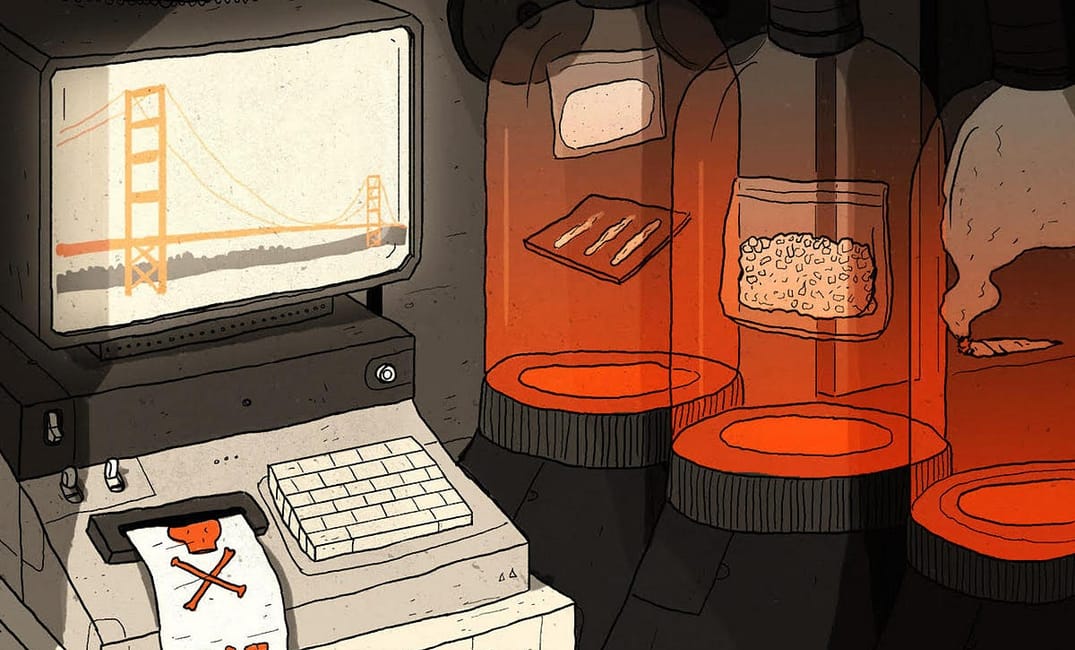You can tell a lot about a place by the kinds of drugs its residents consume. Puget Sound and the Oregon coastal Pacific are caffeinated because of the Pacific Northwest’s coffee addiction. And it should surprise no one that people on the West Coast smoke the most weed, particularly given that California is the number-one producer of pot. Indeed, it’s our state’s most valuable crop, worth an estimated 13.8 billion dollars.
Drugs, both the prescription and black-market kind, tell a story about money, people and trends — they are a zeitgeist of the time. Of course, you can’t just look at DEA stats about illicit drug use to get a sense of how drugs circulate around San Francisco; there are plenty of people doing prescription drugs and pills too.
Using a combination of data sources — including the Substance Abuse and Mental Health Services Administration database, the National Institute on Drug Abuse and the California Department of Health Care Services — I collected data about what drugs are most prevalent in San Francisco, and how that has changed in the past decade. Here’s what I found:
Meth is getting more popular.
Blame Breaking Bad’s Walter White for making meth glamorous again. Medical data indicates that meth use rose across the Bay Area in the first half of 2013. In 2011, San Francisco emergency-room visits for methamphetamine were estimated at “139.5 per 100,000 population for San Francisco,” as opposed to 33 per 100,000 overall in the country as a whole. Maybe it’s not such a rural drug after all.
Opiates kill the most San Franciscans.
In 2009 and 2010, 217 San Franciscans died from opiates. Perhaps this isn’t surprising on its own, as most people think of heroin as one of the hardest drugs. More surprising, though, is the fact that not much of that was heroin: in both years, only 21 deaths were from heroin. Almost half were from methadone, a synthetic opioid used to treat opiate dependence. Nationwide, about 26% of opiate deaths are from methadone; in San Francisco, it’s at least 42%.
Cocaine is a close, deadly second.
From 2009 to 2010, the National Institute of Health reports that 129 San Franciscans died of cocaine overdoses. This doesn’t sound like a huge number, but it’s actually WAY above the national average. In those same years, about 1.4 in 100,000 Americans died of cocaine overdoses. In San Francisco, it was over five times that number.
Though data on cocaine usage in San Francisco became less detailed since 2010, it is clear from regional data that cocaine usage is on the decline. The NIH report on cocaine treatment admission states that “cocaine-treatment admissions continued to decline across the five Bay Area counties” in 2013.
Cocaine is an interesting drug to track because its use essentially parallels economic booms and busts. Cocaine-overdose deaths peaked in 2006, in the midst of the economic bubble, and then reached their nadir in 2009–2010. Since then they’ve been rising steadily. Other economic indicators that track economic bubbles and busts include the heights of the tallest skyscrapers and Lamborghini sales, which — perhaps ominously — have hit record levels.
Drug-assisted suicides usually involve opiates or prescription drugs.
The scant data on drug-induced suicides suggests that antidepressants, benzodiazepines and assorted opiates were the only three type of drugs that were used in drug-assisted suicides in San Francisco in 2009–2010, and not that frequently: less than 20 cases overall were reported of drug-assisted suicide. Oddly, alcohol is not mentioned in the federal data; it could be that it is so common that it is not counted.
Hydrocodone prescriptions are really common.
Usually, we think of hydrocodone as a Florida drug, given that they dispense it there with the same ease with which we dispense medical marijuana — shady prescription mills with “guaranteed” prescriptions “or your money back” recall similar billboards for medical-cannabis doctors you see around California.
However, among addictive drugs, hydrocodone was far and above the most commonly prescribed drug. In the five Bay Area counties, a whopping 1.6 million prescriptions for hydrocodone were scrawled in 2013. This actually marks a decline from 2011, when the number of prescriptions was 1.8 million. Lorazepam and Zolpidem took second and third, with 477,363 and 462,077 prescriptions, respectively, across the Bay Area in the same year.
San Franciscans smoke a lot of weed.
One social scientist analyzed marijuana consumption across the country, dividing the United States into 350 regions and ranking each by its residents’ consumption of marijuana. In his study, San Francisco and Marin County together were ranked 15th for annual use, which, out of 350 regions, puts us in the fifth percentile. In other words, 15.39% of San Franciscans and Marin residents smoke weed each year.
The only California region that ranked higher? The Emerald Triangle region (Humboldt, Mendocino and Siskiyou counties), obviously, which produces more cannabis than anywhere else in the world.







